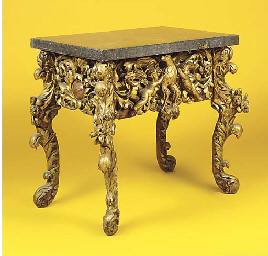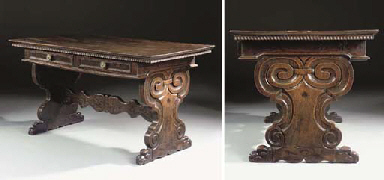One of the major innovations in 17th century furniture design was the console table, which was found in the formal reception rooms of fashionable residences. Console tables were made to display wealth, and were not intended for any practical use. They were typically heavily carved and gilded. Roman console tables quite often had massive supports that were very architectural in design.
Utilitarian tables were made for private, family rooms and for less wealthy homes. Large utilitarian tables with rectangular plank tops above turned legs joined by stretchers are often described as 'refectory' tables, named after the monastery dining halls in which they were commonly used.
Stools or benches were used for seating. Massive bulbous turnings of the legs became less pronounced towards the end of the 17th century, while Louis XIV's influence is evident in the turnings, which were more square in shape and were often carved.
Smaller tables for different purposes appeared in the 17th century, largely because houses were being designed with rooms for specific uses, demanding new types of fitted and non fitted furniture. This coincided with the new fashion for coffee drinking and the growing trend for small, portable pieces.
Some tables could be adjusted in size by the use of drop leaves and extendable tops. This was not a new development - records of tables that could be raised and lowered date back to the 14th century.
Centre tables became popular. These were finished on all four sides (rather than having a plain side to face a wall), and would have been placed in the centre of a room.
Anglo-Dutch Gilt Side Table
Gilt decorated and carved side table, the associated grey fossil marble top on foliate carved base, the frieze centre with an eagle flanked by putti, originally a stand for a cabinet.

Italian Walnut Refectory Table
The rectangular top above a panelled frieze with eight drawers and panelled ends, on turned legs headed by roundels and joined by square stretchers, on bun feet.
Italian Walnut Centre Table
The rectangular top of this handmade furniture item above a dentilled frieze fitted to the front paneled drawers with brass knobs, the back with simulated drawers, on scroll-shaped trestle supports joined by a waved stretcher carved with flowerheads and foliate sprays, teminating in paw feet.

French Walnut Table
The slate inset of this antique furniture piece is a later, replacement of the original slate, and is surrounded by a walnut frame. The frieze is carved with a geometric motif, derived from architectural design, which is found on furniture of this calibre from the late-16th century. The tapering turnings are a typical late-16th/17th century model and the wide stretchers with deep moulding on the edge. The feet are later replacements. Good original colour and patina.

Awesome post!
ReplyDeleteMust have a look atUseful Tips for your Wooden Tables